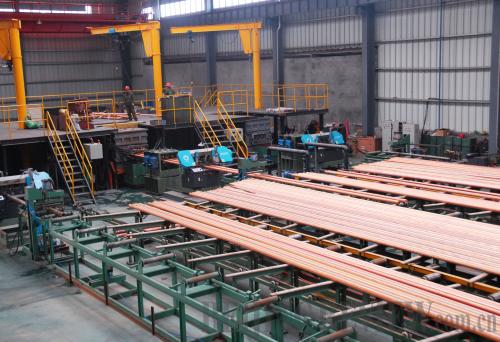|
 |
|
PROSPEROUS ANHUI: Copper tubes are processed at a Zhejiang Hailiang Co. Ltd. factory in Tongling, Anhui Province. The company, based in Zhejiang Province, is attempting to explore and expand into the booming market of Anhui (HU YUE) |
Wage growth and land costs inflation are prompting relocation of China's manufacturing juggernaut, a growth engine of the Chinese economy. Anhui Province in central China is one of the biggest beneficiaries.
On January 12, 2010, the State Council approved planning for the Wanjiang River Urban Belt as an industrial transfer demonstration zone. The zone—covering nine cities along the Yangtze River in Anhui—accounted for 66 percent of the province's economy. Its ambitious goal was to double the GDP by 2015 from the 2008 level.
In the first 11 months of 2010, the zone received 401.2 billion yuan ($61.7 billion) in investments from outside the province, soaring 57.5 percent from one year earlier, said the Anhui Provincial Development and Reform Commission.
The inward spread of industries could provide a welcome buffer for the Chinese economy as massive stimulus tapers off and uncertainties gather over export prospects. Since east coastal regions are losing steam after years of turbo-charged growth, the take-off of the central areas is considered an important fillip.
"This is an overwhelming process that is going to reshape the economic geography of China," said Li Yang, Vice President of the Chinese Academy of Social Sciences. "The possibility that central China can take on the baton of development from the maturing eastern provinces is clearly good news for the Chinese economy."
"With a solid industrial foundation, Anhui has deep potential to become a significant component of China's manufacturing machine," he said.
"We have learned from experiences of the east coastal provinces and are determined to reject energy-guzzling and highly polluting enterprises," said Wang Sanyun, Governor of Anhui Province.
"Moreover, it is necessary to encourage technological innovation and enhance value creations during the transfer process," he said.
The zone has put priority on a few key sectors, equipment manufacturing, hi-tech and modern services, said Shen Weiguo, Director of the Anhui Provincial Development and Reform Commission.
"Efforts are also being made to improve infrastructure and public services to accommodate large-scale industrial transfers," Shen said. "We aim to foster several globally competitive giants and world-renowned brands."
Moving inland
Riding the wave of industrial transfer was the Shanghai Huayi Group, which in October 2008 joined hands with partners to build a coal chemical plant in Chaohu, Anhui.
"We investigated many other places like Ningbo and Wenzhou in Zhejiang Province and Qinhuangdao of Hebei Province," said Hu Guowei, general manager of the plant. "But eventually we chose Anhui because of its proximity to Shanghai and rich coal resources."
After coming into operation in November 2011, the plant is expected to generate sales revenues of 50 billion yuan ($7.7 billion) annually, he said.
But what really set the company apart from its counterparts was a deep-rooted commitment to striking a balance between environment and production. The ashes left over from coal burning are used to make bricks and other construction materials, while wastewater is also purified for circulation. In addition, all coal is required to go through desulphurization before burning to protect the environment and minimize the erosion of metal equipment.
"The recycling model has offered insurance of operational efficiency, and brightened our outlook for future growth," said Hu.
Another example is the Zhejiang Hailiang Co. Ltd. that invested 1.5 billion yuan ($230.8 million) in late 2010 to build a factory of air conditioner copper tubes in Tongling, dubbed the copper capital of China. Prior to that, the private company owned three copper processing plants each in Zhejiang, Shanghai and Viet Nam, respectively, and relied on the overseas markets for more than 70 percent of sales.
"But due to the global financial crisis, our exports received a heavy blow," said Fu Lingzhong, general manager of the factory. "The protectionism restrictions also made a dent to the export businesses."
In October 2010, the United States slapped anti-dumping duties on copper tubes imported from China, claiming that they threatened to materially injure domestic producers.
"That is why we decided to switch to the thriving domestic markets," Fu said. "Now the company supplies copper tubes to Gree and Midea, China's top air conditioner manufacturers.
Relatively low labor and freight costs have provided a solid floor under the company's profitability, cushioning the impact of copper price surges, Fu said.
| 